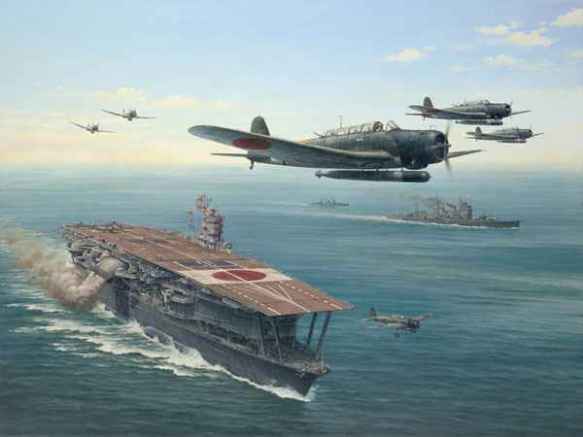
At the onset of the Pacific war in December 1941, B5Ns formed the core of elite Japanese carrier aviation. They received the Allied code name Kate. The deadly effectiveness of the B5N was underscored during the attack on Pearl Harbor when 146, flying as light bombers and torpedo craft, sank eight U.S. battleships.
Commander Mitsuo Fuchida
Commander Mitsuo Fuchida’s B5N2 at Pearl Harbor.
AT DAWN ON 7 DECEMBER 1941, Japanese pilots for the first wave of the attack on Pearl Harbor climbed into their cockpits, each carrying a rations pack for the flight – rice and plums, chocolate, and pep pills. Propellers spun and engines roared into life as the leader of the attack, Commander Mitsuo Fuchida, donned the traditional hachimaki headband. Despite a choppy sea, 183 aircraft took off without incident and formed up to set course for the Hawaiian island of Oahu, observing strict radio silence. For much of the flight there was low cloud. Fuchida corrected his bearing as he closed on the target by taking a fix on a music programme broadcast by a Honolulu radio station – which also gave an update on local weather conditions. Then the cloud broke and the pilots were looking down on the lush green island. As Pearl Harbor came into view, Fuchida saw “the whole US Pacific fleet in a formation I would not have dared to dream of in my most optimistic dreams”. A total of 90 ships lay at anchor or in dry dock, including eight battleships. In the excitement of the moment, Fuchida radioed the carrier force with the signal for victory – “Tora, tora, tora” – as the first strike went in, the torpedo-bombers skimming in low over the water and dive-bombers sweeping down from 3,500m (12,000ft). The air was thick with the smoke of explosions by the time the horizontal bombers, led by Fuchida, advanced in single file through anti-aircraft fire, while Mitsubishi A6M Reisen (“Zero”) fighters swooped down to strafe the military airfields below. Almost 300 American planes were damaged or destroyed on the ground, and the Japanese had the air almost to themselves. In the midst of the mayhem, a flight of B-17 bombers arriving from the mainland United States were badly shot up.
The Japanese pilots were oblivious to the human drama unfolding on the ships and ground below, concerned only to carry out their tasks successfully. Many returned to their carriers in personal shame amid the general euphoria, convinced they had missed their targets, letting down their colleagues and their emperor. But Fuchida stayed over Pearl Harbor during the 170-plane second wave of the attack and was able to report to Admiral Nagumo on the damage caused. The admiral commented, “We may then conclude that anticipated results have been achieved.” That just about summed it up.